Before this trip towards the end of 2021 I was very, very tired and I needed a serious change of scenery, as I like to put it. For all sorts of reasons I did not travel outside the country since January 2020 and although I kept making different plans, there was always something. However, at the end of November I had a week off, so I decided to use that.
I started to think of possible destinations, but then I had to take the complex covid situation into consideration as well, so eventually I came up with a “summer vacation” in Hurghada in Egypt almost in the middle of winter. Too short, it seemed to me, but better something than nothing. I literally decided to go a week before the departure.
My plan was to have a good and proper rest, so I opted for an all-inclusive resort, with an idea right away to go on a day’s excursion to Luxor.
And here we come to the story about Ancient Egypt and the “+ 2001” from the title. Namely, I had already been to Egypt a few times, including also in 2001 when I went with my mom for a wonderful and relatively thorough sightseeing trip around Egypt, which also included a cruise on the Nile. On that occasion we came here on a tour that was rather usual for that time, but on top of that we went for an excursion from Aswan to Abu Simbel, plus after 12 days, which was the duration of the tour organised by an agency, we remained in Egypt for additional 5 days as a private arrangement. The reason was very specific – namely, my mom’s paternal grandmother, i.e., my great-grandmother was buried in Egypt of all places, in Alexandria to be exact, so I made a plan how to do a search for my great-grandmother’s grave, which required time.
Back in 2001, I made photos using a slide-film, so I have fewer photos, while the quality is quite questionable, plus I also have relatively a lot of video material, although it has considerably degraded in the meantime. However, I have decided anyway to share some of the stories from that trip within this travelogue. After all, it’s unlikely that anything major in connection with Ancient Egypt happened in the last 20 years. It is nothing in comparison to the millennia that have passed since the disappearance of this civilisation the duration of which is also measured in terms of millennia.
Basically, I have envisaged this travelogue as stories about the 2001 trip, with a contemporary addition from 2021 which includes Hurghada and Luxor. Here is the map of Egypt with marked places that will be covered by my stories.
Upon our arrival in Cairo in 2001, we had an organised coach sightseeing tour around the city and the surroundings. First we went to Memphis, the archaeological remains of the old capital of the Old Kingdom that was located in Lower Egypt. By the way, I must admit that I have always been confused by this “Lower” and “Upper” Egypt – when you look at a contemporary map, the situation is reverse in relation to the meaning of these words. Namely, Lower Egypt refers to the northern part of the country which is always “up” in the map, while Upper Egypt is more to the south, i.e., “lower” in the map. These denominations “lower” and “upper” are actually linked to the Nile – its upstream segments are “upper,” while the downstream segments and the delta are “lower.” Well, that makes sense.
Memphis was founded more than 3100 years before the Common Era at the beginning of the Nile delta, while it was abandoned in the 7th century CE. It was the capital of the Old Kingdom, which is the name used for united Lower and Upper Egypt. These two areas of prehistoric Egypt were united precisely around 3100 BCE with Memphis as the capital and this concept of Egypt as a kingdom of these two territories is very important for the culture of Ancient Egypt and often appears in texts and depictions, as well as in the names of pharaohs.
Nowadays, the remains of the city may be seen close to town Mit Rahina, around 35 km south of Cairo.
The site of Memphis is not very big and what may be seen there today certainly does not reflect all the significance of one of the capitals of such a large and important civilisation as Ancient Egypt. When you get to the site, you can see the Sphinx of Memphis in its middle. Namely, there used to be a Great Temple of Ptah, the creator god and patron of craftsmen and architects. The Sphinx was placed at its entrance as a guardian and it was made as a monolith (out of a single block of stone) around 1400 BCE.
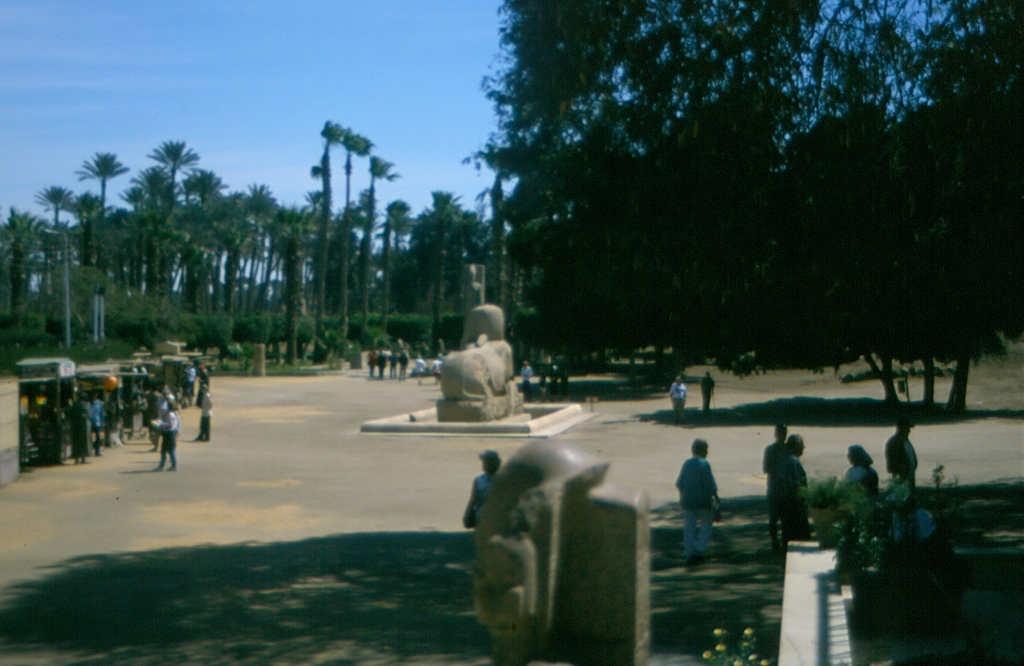 Alabaster Sphinx in Memphis
Alabaster Sphinx in Memphis
In Memphis, you can also see a huge statue of Ramesses II (1279-1213 BCE). Together with another such huge statue, it used to decorate the entrance into the Temple of Ptah built by Ramesses II. The statues were found in the second half of the 19th century and it is interesting that at the time they were offered left and right to various parties as a gift, but (luckily) the gifts were declined on account of the high transportation costs. Nowadays, one of these two statues is in Memphis, laid down on its back, since it has been damaged over time and the lower parts of its legs have not been found, but the other one was found in pieces and restored meanwhile. It was first displayed in the centre of Cairo, but in 2006 it was transferred to a museum in Giza. The height of these statues is around 10-11 m. You can see the size in the following photo where there are also two men, as points of reference. What cannot be seen in the photo, because of the poor quality and the angle at which the photo was taken, is the fineness of sculpting, since the statue shows, for instance, muscles that clearly suggest a young man, while it is presumed that at the time when the statue was made Ramesses II was around 35. On his head, the pharaoh wears a white crown, the symbol of Upper Egypt with Uraeus – the rearing cobra which is the symbol of Lower Egypt.
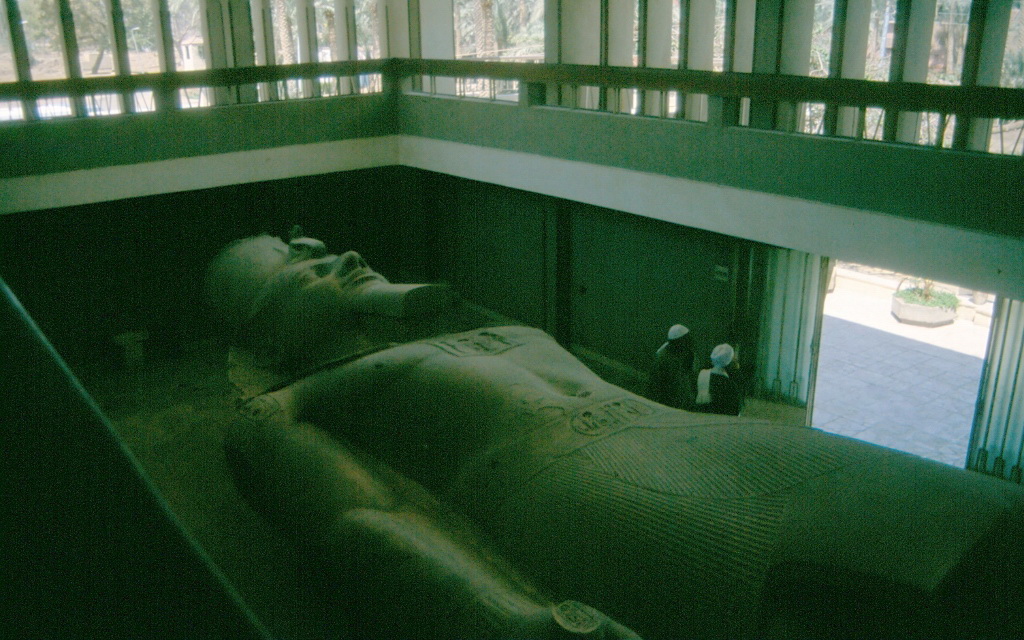 Statue of Ramesses II in Memphis
Statue of Ramesses II in Memphis
We continued with our visit in the direction of the Sphinx, so we could see it from the front. The photograph was made from an old video. This monument is often referred to as the Alabaster Sphinx, although it was actually made of calcite.
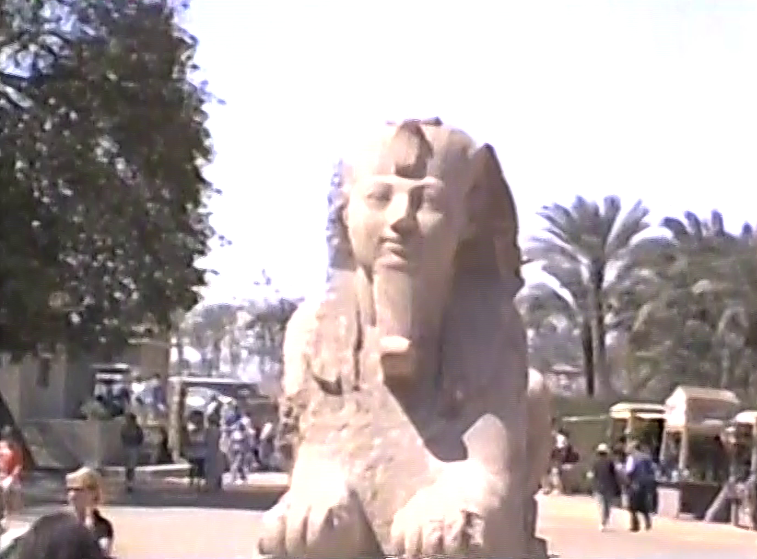 Alabaster sphinx in Memphis
Alabaster sphinx in Memphis
Then we went to yet another statue of Ramesses II, but this one was made of red granite, as opposed to the lying one made of limestone. This one is also smaller, but it stands upright.
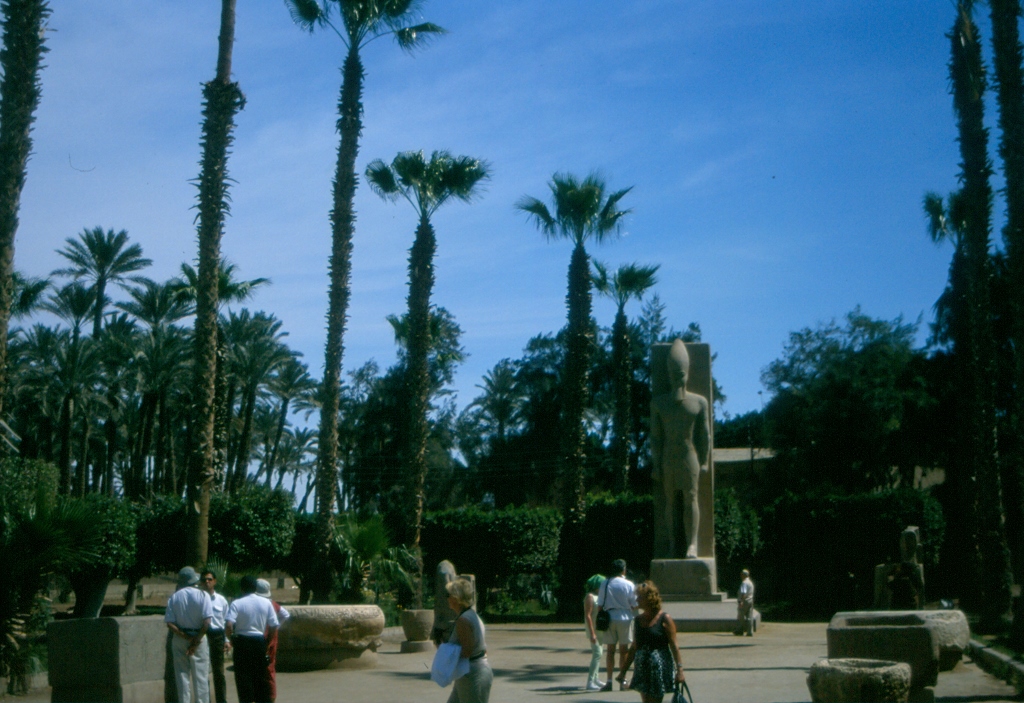 Ramesses II statue made of red granite
Ramesses II statue made of red granite
After this visit, the group returned to the coach and so we continued to a nearby area west of Memphis which is situated around the village of Saqqara. Namely, there is an Ancient Egyptian necropolis in this area, i.e., a cemetery for pharaohs and members of the royal families, but even when they started to be buried in Giza or more to the south, in the Valley of Kings near present-day Luxor, this area was still used for the burials of high officials – over the period of next 3000 years! It is best known for the Step Pyramid of Djoser, built for Pharaoh Djoser, a ruler from the 3rd dynasty, around 2650 BCE.
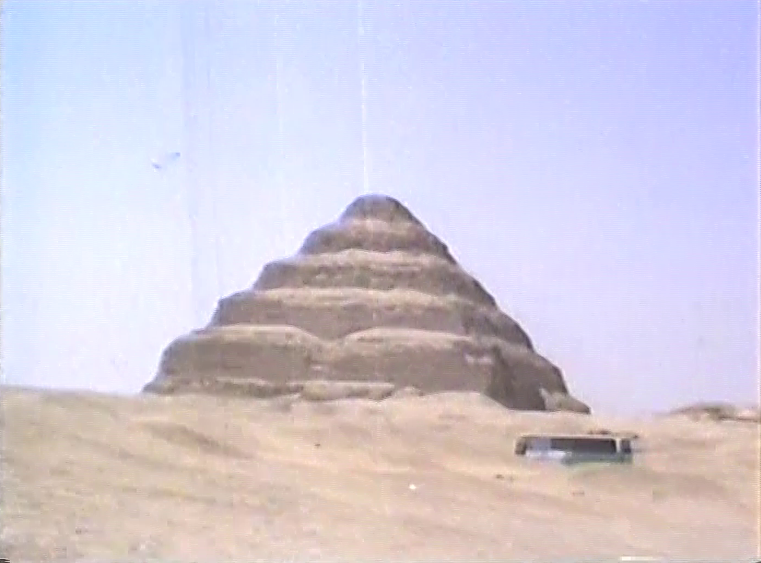 Step Pyramid of Djoser
Step Pyramid of Djoser
The Step Pyramid of Djoser is the oldest completely preserved stone structure in history. When it was constructed, the pyramid was 62.5 m high, while the sides of its base were 109 m x 121 m. Nowadays, the pyramid is around 60 m high and it is just a part of the complex within which Pharaoh Djoser was buried.
Originally, this pyramid was in fact built as a mastaba, an old type of Ancient Egyptian tomb, a platform that usually has the shape of a low truncated pyramid that was expanded over time. Eventually the construction started going up until the shape we can see today was attained.
We came close to the Pyramid of Djoser, but did not get in. As our guide told us, theoretically this was possible, but it was deemed dangerous. However, according to what I have read, today (written in 2021), after a thorough restoration that took a considerable number of years, it is indeed possible to enter the pyramid.
Related to this pyramid that is to the north, there was another pyramid supposed to be built to the south, but this was not done. Instead of that, a copy of the pharaoh’s palace was built so that in the immediate surroundings of his tomb he would feel as if he were at home.
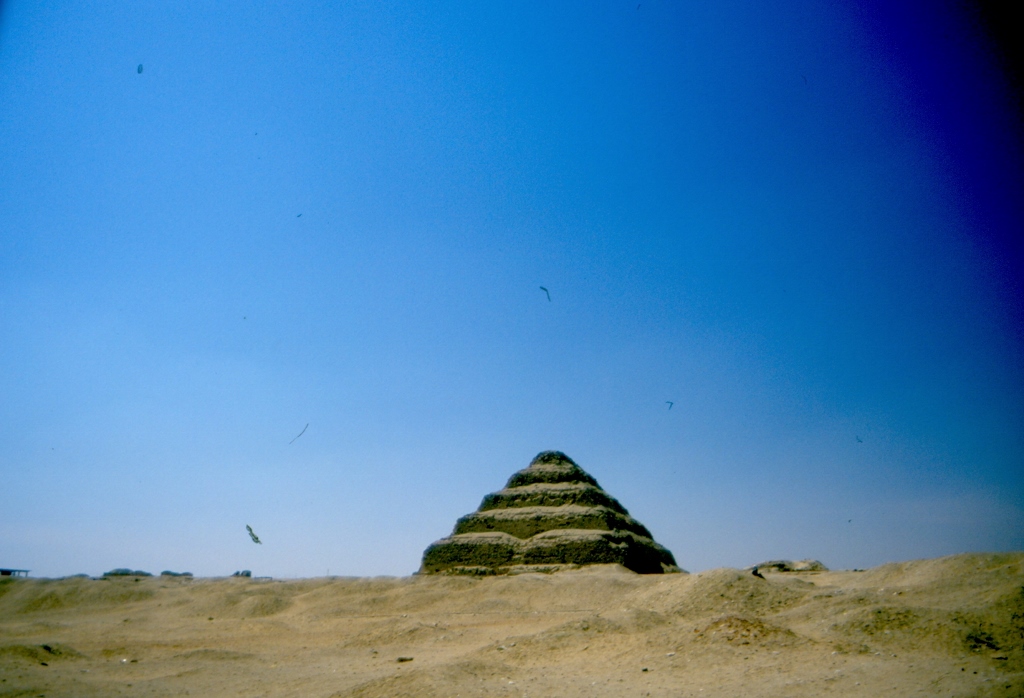 Step Pyramid of Djoser
Step Pyramid of Djoser
When one goes around this area where the necropolis is, a large contrast may be seen (from the coach, in our case): on the east side there is the green and flat valley of the Nile, while west of that greenery there is the desert which is on an elevation in relation to the valley. The pyramid tombs were built on that elevation for two reasons. The first one was so that the waters of the Nile could not reach the tombs during the flooding and the second one was so that the people could admire the literally elevated position of the tombs. But, from that elevation there is also a fine view at the surroundings, which may be corroborated by a “parked” camel.
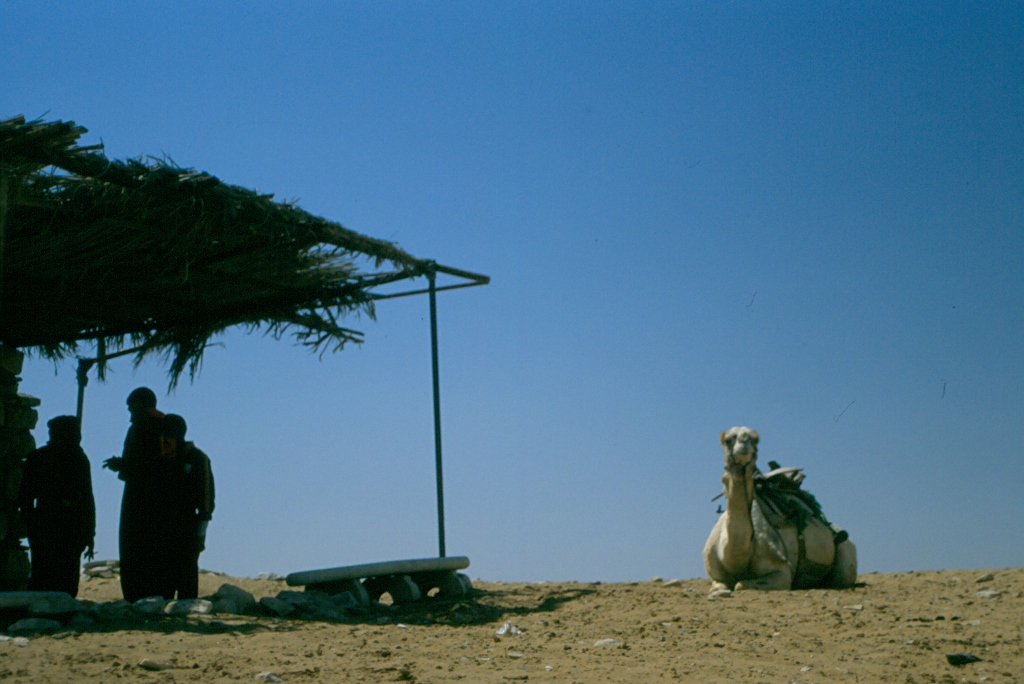 Good view from up above
Good view from up above
The Ancient Egyptians apparently liked the pyramid shape, so after the Step Pyramid of Djoser, they continued to apply this shape when building tombs of their pharaohs. However, to build a perfect pyramid shape is not that easy and therefore today in this area one can see numerous pyramids that are not of the step kind or that do not have the regular shape, instead their sides are askew.
Still, the Ancient Egyptians were not ready to give up easily and over time they did reach the perfection – the famous pyramids in Giza.
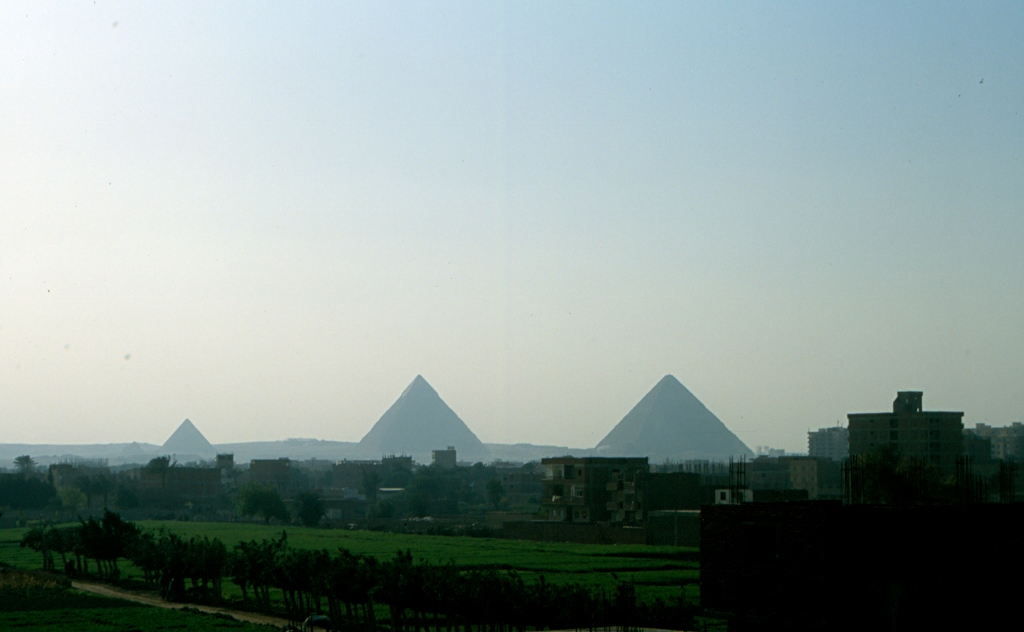 Pyramid Complex in Giza from afar
Pyramid Complex in Giza from afar
The Pyramid Complex in Giza includes three main and a large number of smaller pyramids and other structures, including also the Great Sphinx. By the way, Giza is a large city situated around 20 km southwest of the centre of Cairo, but nowadays these are practically agglomerated urban settlements, so that Cairo that has in the meantime “swallowed up” other settlements in its surroundings as well today has over 20 million inhabitants.
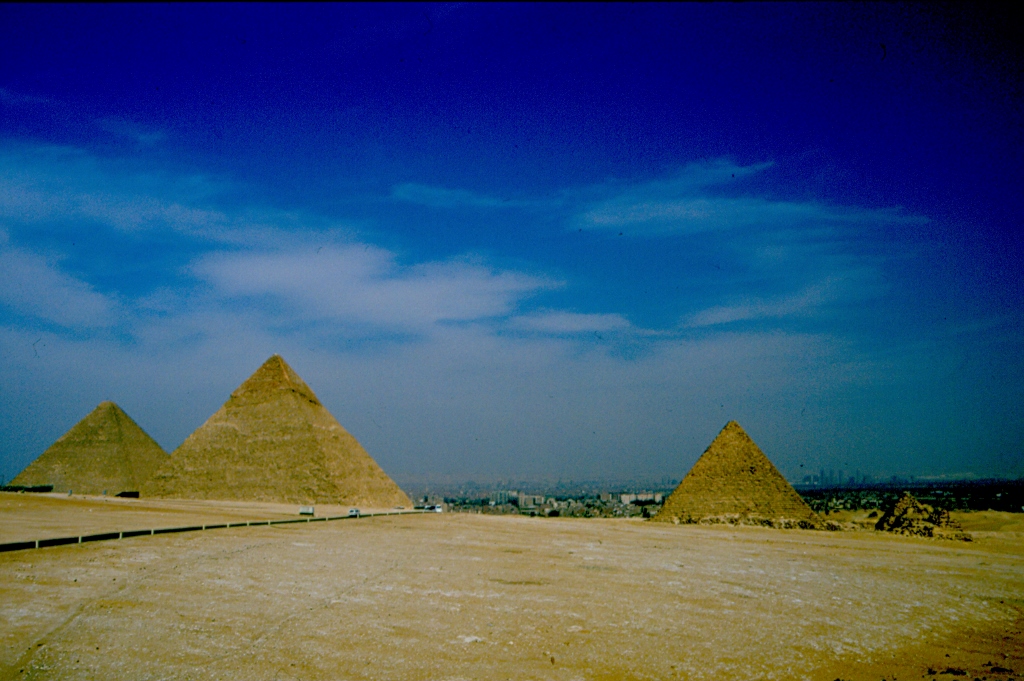 Pyramid Complex in Giza: from left to right: Pyramids of Khufu, Khafre and Menkaure
Pyramid Complex in Giza: from left to right: Pyramids of Khufu, Khafre and Menkaure
The pyramids in Giza (or to be more accurate only the biggest among them) are a part of the famous Seven Wonders of the Ancient World, but are the only ones that have survived to date. No wonder – they are simply huge. Especially the biggest among them, which is the Pyramid of Khufu. It was built at the order of Pharaoh Cheops (ancient Greek name) or Khufu (ancient Egyptian name) who was a ruler from the 4th dynasty and who ruled in the period from 2589–2566 BCE. (In other words, the ancient Egyptians took around 100 years to get from the first, step pyramid and numerous intermediate phases to the perfect shape).
Although, when looking at the above photo, one may get an impression that the middle pyramid, of Khafre, is the biggest, this is not true – in addition to the trick played by the different perspective in the photo, it is also located on a slightly more elevated place, while in fact being 10 metres lower than that of Khufu. It is particularly interesting, however, since the casing still exists on its top. The construction of the Great Sphinx of Giza is also attributed to this pharaoh who was the son of Khufu. The third and the smallest of the great pyramids in Giza is that of Menkaure who was the son of Khafre.
As for the pyramid of Khufu, it was built around 2560 BCE. The length of its side is 230 m, while the height is almost 138.50 m, although originally it was 146.50 m. It used to be completely covered in panels and smooth, but over time, the casing was removed and now one can only see the stone blocks it was made of. There are around 2.3 million stone blocks and on an average they each weigh more than 2 tonnes!
When I was a child and dreamed of going to Egypt and visiting the pyramids, I always imagined I would climb up to the very top. Of course, this is not allowed, which is more than fine, but it is possible to visit the interior of the pyramid. On this occasion, we did not have enough time for me to do that, so I just climbed a little bit, to the third row of the stone blocks (there are steps), so I posed. The size of the people in the photo clearly illustrates how enormous a structure this is.
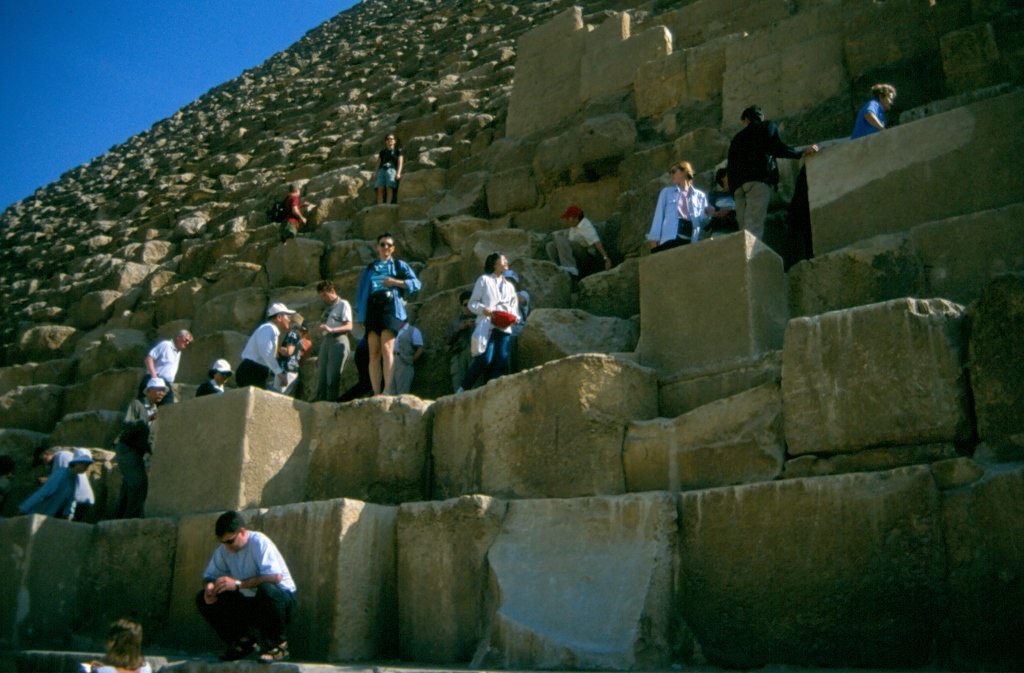 Posing on a stone block of the Pyramid of Khufu
Posing on a stone block of the Pyramid of Khufu
This visit to the Pyramid Complex in Giza was too superficial for my taste and to this very day I have been left with an impression that I did not see enough and that it is absolutely necessary for me to go back there. Perhaps I will do it one day. In any case, back in 2001, after a short visit to the Pyramid of Khufu, we moved to a flat elevation from which there was a fine view, but also there were local vendors with different souvenirs and camels.
Here I managed to convince my mom to get on a camel. Since she wore a dress and there was a strong wind, it lifted her dress, but the skilful and ready salesman immediately pulled a large scarf over my mother’s legs, so the getting up of the camel could start. I don’t know if you have ever ridden a camel, but this getting up and down of a camel may be quite amusing for the inexperienced and unskilful. Not only my mom and me, but also several other people from our group climbed onto those poor camels and it was a very comical and laughable experience.
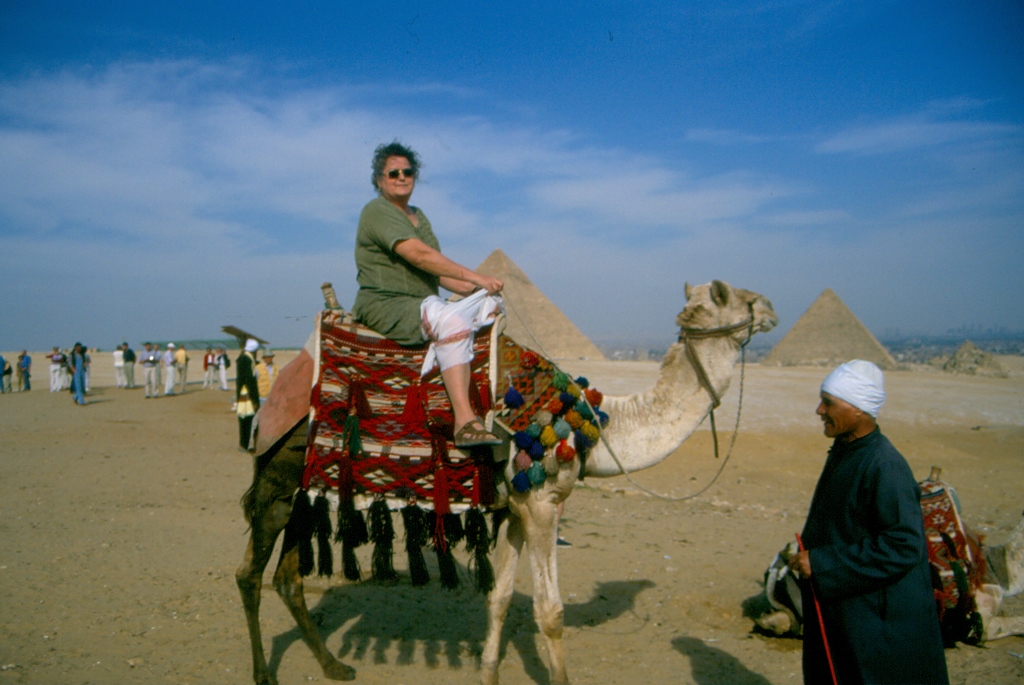 My mom on a camel, with the Pyramids of Giza in the background
My mom on a camel, with the Pyramids of Giza in the background
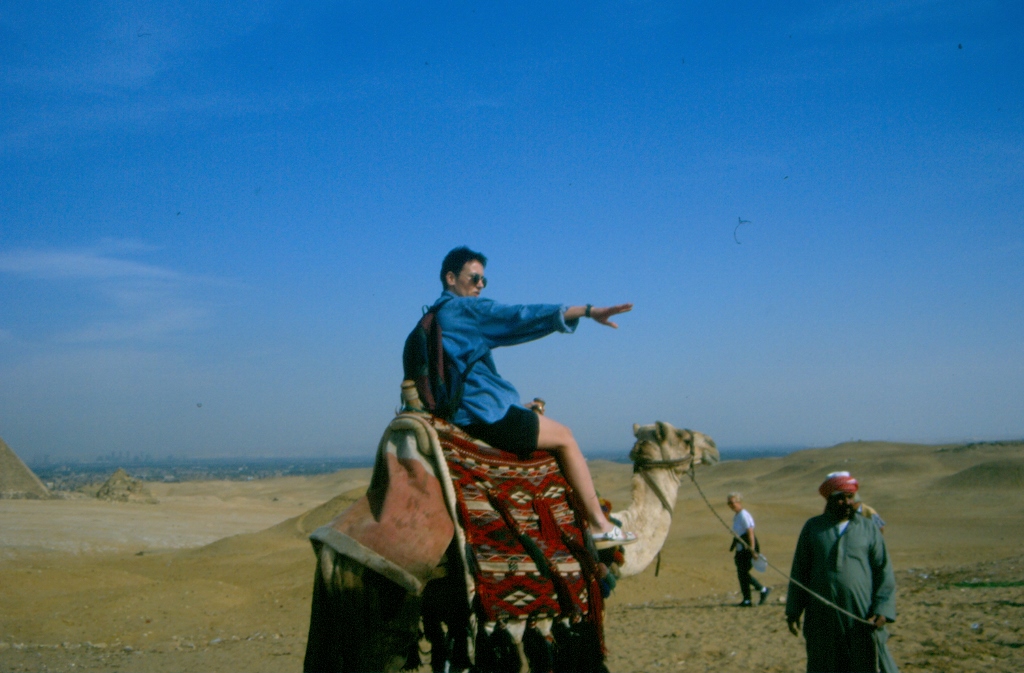 I could almost be a general
I could almost be a general
Then we went back to the Great Pyramids where I entered the Pyramid of Menkaure, but I have no visual record of it and only remember that it was not particularly spectacular or too claustrophobic, but it was certainly hot. After that short break, we got into the coach again and passing by the pyramids and the Great Sphinx, we got to a plateau in front of it.
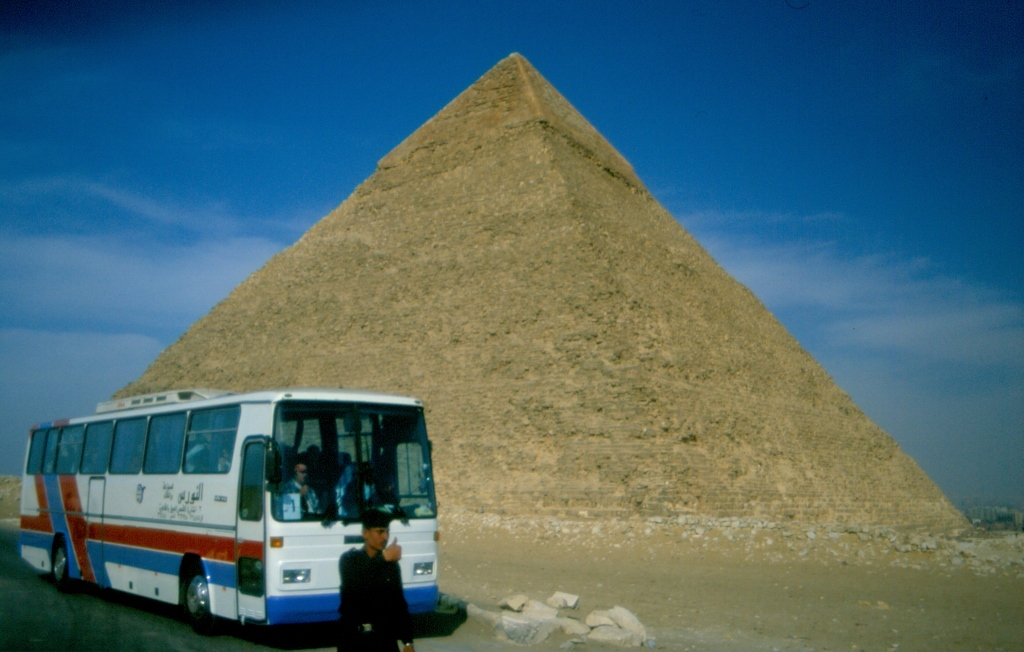 Pyramid of Khafre
Pyramid of Khafre
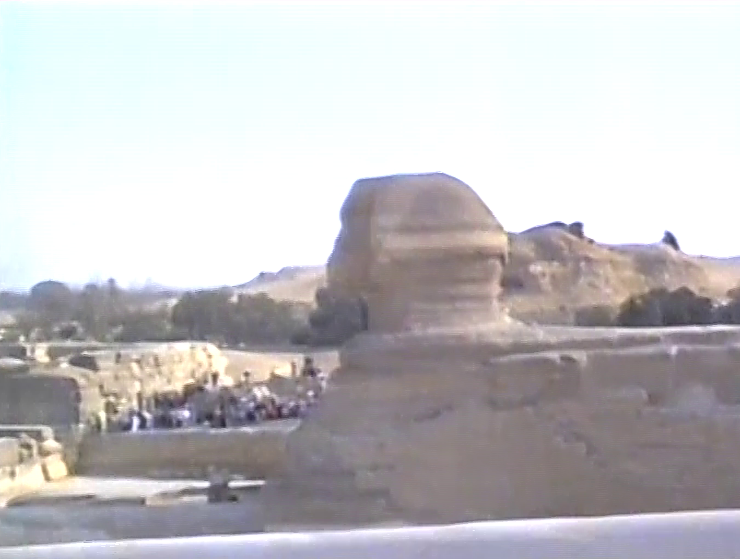 Passing by the Great Sphinx by coach
Passing by the Great Sphinx by coach
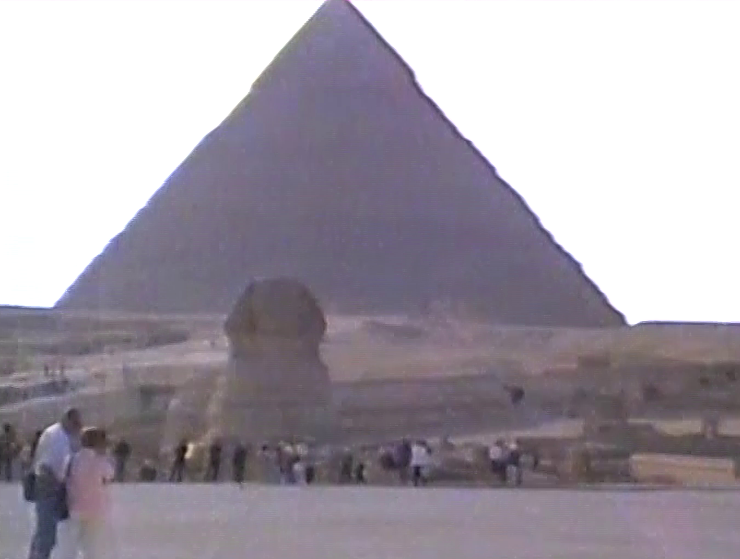 Plateau from which it is possible to see the Great Sphinx, as well as the Pyramid of Khafre in the background
Plateau from which it is possible to see the Great Sphinx, as well as the Pyramid of Khafre in the background
And here this coach excursion of 2001 ended and I was left with a feeling that this was simply not enough. Obviously, I would like to go back to Egypt and Cairo, but as an independent traveller, so that I have enough time to visit in detail everything that I’m interested in and when it comes to Ancient Egypt I’m interested in almost everything.